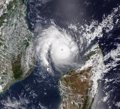Nov. 8 () –
Space X has scheduled the sixth test flight of its interplanetary superrocket prototype Starship for Monday, November 18, with a 30-minute launch window starting at 22:00 UTC.
In the fifth flight test, on October 13, the Super Heavy rocket successfully returned to the launch site and was caught by the stick arms of the launch tower and capture at Starbase, located in Boca Chica (Texas). The Starship upper stage continued to demonstrate several improvements, resulting in controlled entry and high-precision splashdown in the target area in the Indian Ocean.
Starship’s upcoming flight test aims to expand the capabilities of the ship and booster and move closer to reusability of the entire system. The objectives include the booster returning once again to the launch site for capturere-ignite a ship’s Raptor engine while in space and test a set of heat shield experiments and maneuver changes for the ship’s re-entry and descent over the Indian Ocean.
“The success of the first capture attempt demonstrated the feasibility of the design while providing valuable data to continue improving hardware and software performance. The hardware upgrades for this flight add additional redundancy to the booster propulsion systems, increase the structural strength in key areas and shorten the time to discharge booster propellants after a successful capture,” details Space in a statement. Mission designers also updated the software controls and commitment criteria for booster launch and return.
Analogous to the fifth flight test, various vehicle and platform criteria must be met prior to return and capture of the Super Heavy booster, which will require healthy systems in the booster and turret and a final manual order from the mission flight director.
THE ROCKET WILL ONLY RETURN TO THE TOWER IF IT IS SAFE
If this command is not sent before the return burn is complete, or if the automatic health checks show unacceptable conditions with Super Heavy or the tower, the booster will adopt a predetermined trajectory leading to a landing burn and a soft splashdown in the Gulf of Mexico.
“We accept no compromises when it comes to ensuring the safety of the public and our team, and the return will only take place if the conditions are suitable”, adds Elon Musk’s company.
The returning thruster will slow down from supersonic speeds, which will cause audible sonic booms in the area around the landing zone. Generally, the only impact to those in the surrounding area of a sonic boom is the brief thunder-like noise, and variables such as weather and distance from the return site determine the magnitude experienced by observers, according to the statement. .
Starship’s upper stage will fly the same suborbital trajectory as the previous flight test, with a planned splashdown in the Indian Ocean. An additional objective for this flight will be attempt a combustion in space using a single Raptor engine, further demonstrating the capabilities needed to perform a deorbit burn of the spacecraft prior to orbital missions.
Various thermal protection experiments and operational changes will test the limits of Starship’s capabilities and will generate flight data to inform ship capture and reuse plans. The flight test will evaluate new secondary thermal protection materials and will remove entire sections of thermal protection plates from both sides of the craft in locations that are being studied for capture-enabling hardware on future vehicles.
The craft will also intentionally fly at a higher angle of attack in the final phase of descent, deliberately stressing the limits of flap control to obtain data on future landing profiles. Finally, adjust the flight takeoff window to the afternoon in Starbase will allow the ship to re-enter the Indian Ocean in daylightwhich will provide better conditions for visual observations.






![[Img #74661]](https://thelatestnews.world/wp-content/uploads/2024/12/The-power-of-ultrasound-150x150.jpg)






![[Img #74661]](https://thelatestnews.world/wp-content/uploads/2024/12/The-power-of-ultrasound-300x200.jpg)


Add Comment